The United States and India have steadily increased cooperation among our defense and security forces through information sharing; defense planning, exercises, and exchanges; defense industrial cooperation; and counterterrorism and law enforcement activities.
January 2021
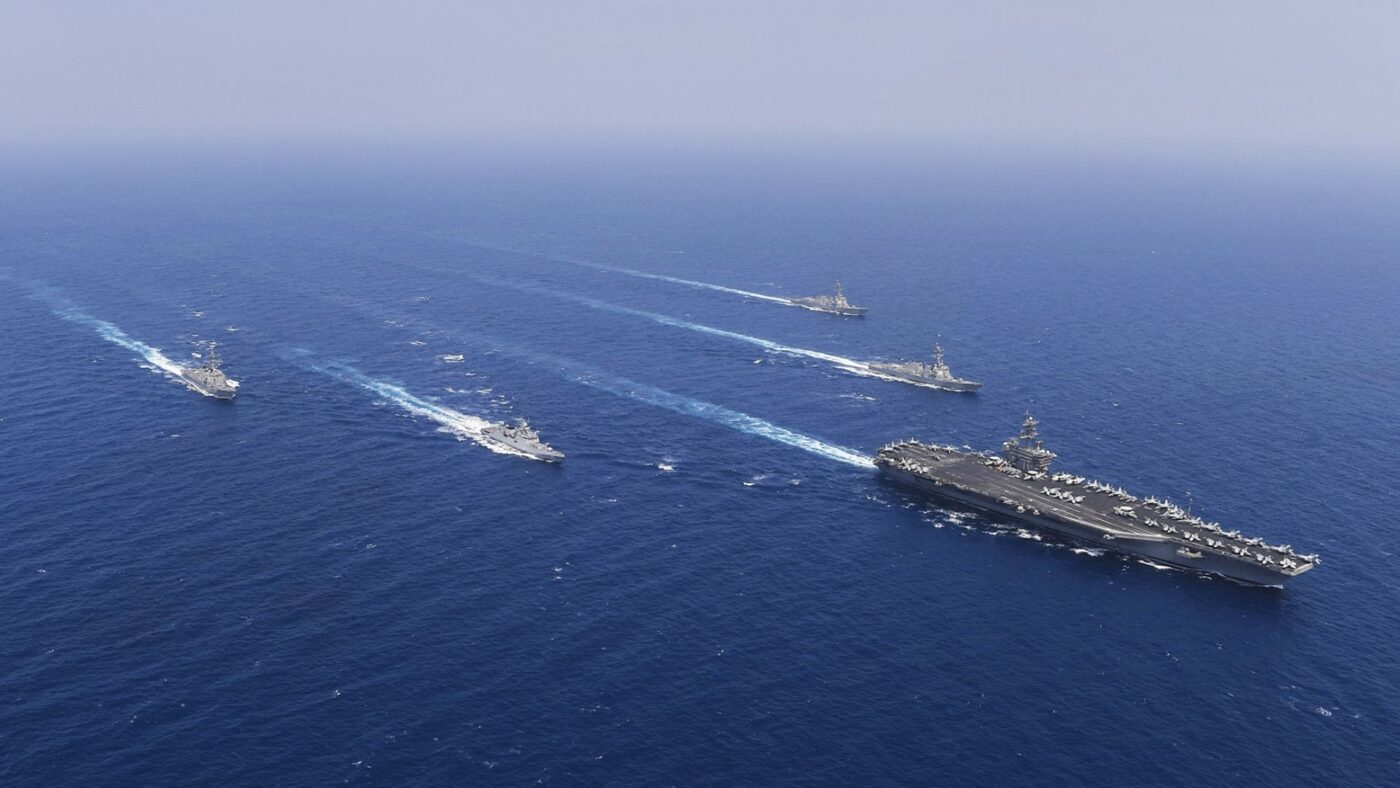
U.S. and Indian Navy ships sail in formation in the Indian Ocean in March 2018. Photograph by U.S. Navy/Mass Communication Specialist 3rd Class Spencer Roberts
As the world’s two largest democracies, the United States and India share a responsibility to protect our citizens and help provide security and stability in the Indo-Pacific region. As proud nations with long histories of achievement and contributions to humanity, we are committed to defending our sovereignty and territorial integrity from external coercion. And as entrepreneurial nations, we understand that prosperity and development require security.
Drawing on these shared principles and with firm support from our citizens, the United States and India have steadily increased cooperation among our defense and security forces through information sharing; defense planning, exercises, and exchanges; defense industrial cooperation; and counterterrorism and law enforcement activities. This has involved sharing some of our countries’ most sensitive information and technology, as well as dedicating substantial personnel and resources to joint efforts.
We have done this because the United States and India face common threats and challenges, ranging from unilateral efforts to change borders and disrupt the rules-based international order, to regional and global terror networks, to drug traffickers and malicious cyber actors. We have sought to keep our nations safe today, but also to increase interoperability and habits of cooperation among our defense and security forces so that we are prepared to deal with the threats of tomorrow.
By strengthening our shared resolve and ability to confront common threats, we make clear to our publics and the world our determination to defend our development goals, our democratic way of life, and the rules-based international order.
A History of Defense and Security Cooperation
U.S.-India defense and security cooperation is not new. During the Korean War (1950-1953), the Indian government warned the United States of the impending Chinese entry into the conflict and the threat to U.S. troops. India and the United States then worked together at the United Nations to denounce the aggression against South Korea. India later sent the 60th Parachute Field Ambulance Platoon to the Korean Peninsula to support the United Nations forces, which included U.S. troops.
Later, as tensions built on India’s northern border, President Dwight D. Eisenhower visited India in December 1959 to show solidarity with the Indian government and people. When conflict with China broke out in October 1962, the United States stood by India, responding quickly to Indian requests for military assistance. The United States flew in clothes, weapons, and ammunition, first to Kolkata, and then to the front lines, on U.S. Air Force C-130s.
After a long period of strained ties, our defense and security partnership restarted and then expanded in the 1990s and 2000s, with regular military exercises, new policy agreements, and increased cooperation on counterterrorism. In 1992, the U.S. and Indian navies began annual joint exercises, called Malabar, to coordinate on maritime security and disaster response. In 1995, our governments formalized our growing military cooperation with the Agreed Minute on Defense Relations, then broadened it in 2005 when Secretary of Defense Donald Rumsfeld and Indian Minister of Defense Pranab Mukherjee signed the New Framework for the U.S.-India Defense Relationship. In 2004, our armies began the Yudh Abhyas exercise and our air forces launched the Cope India exercise.

Indian Defense Minister Pranab Mukherjee and U.S. Secretary of Defense Donald H. Rumsfeld establish a new framework for the U.S.-India security relationship, in Washington, D.C. in June 2005. Photograph courtesy defense.gov
Tragically, both the United States and India have long suffered from terrorist attacks, including from transnational groups with links to state-based actors. As attacks against each of us increased in the 1990s and 2000s, we recognized our common interest in cooperating against terrorism and started to work together to strengthen our resolve and our joint efforts. In 2000, we established the U.S.-India Counter Terrorism Joint Working Group to coordinate policies and share information. We expanded this cooperation with the Counterterrorism Initiative in July 2010, which covered maritime and border security, investigations and forensics, and terrorist financing, and included cooperation between counterterrorism units such as the National Security Guard. In the same year, we announced the creation of a cabinet-level U.S.-India Homeland Security Dialogue to ensure high-level support for counterterrorism and law enforcement cooperation.
During his November 2010 visit to Mumbai, U.S. President Barack Obama commemorated the November 2008 attacks in the Maximum City that killed Americans as well as Indians, while emphasizing the importance of our joint efforts to combat terrorists. President Obama stated: “Our governments have worked closer than ever, sharing intelligence, preventing more attacks, and demanding that the perpetrators be brought to justice.”
Recent Expansion of Ties: India as a U.S. “Major Defense Partner”
In the last few years, we have deepened our defense and security cooperation in order to keep our nations safe from a growing array of threats, and to provide security beyond our own borders. This effort has had strong support from our leaders, and is clearly reflected in our official statements and strategic documents. The 2015 U.S. National Security Strategy highlighted the growing priority given to India and U.S.-India ties, as it affirmed the U.S. intention to strengthen the relationship and to support India’s growing role as a regional provider of security.
In 2016, the U.S. Congress designated India as a “Major Defense Partner,” making it the only country to hold this special status. This designation supported India’s access to sensitive defense technology and reinforced India’s significant role in U.S. national security strategy. The 2017 National Security Strategy document welcomed “India’s emergence as a leading global power and stronger strategic and defense partner,” stating clearly the importance of our growing relationship. In 2018, the U.S. Department of Defense changed the name of its regional combatant command, based in Hawaii, from the U.S. Pacific Command to the U.S. Indo-Pacific Command, reflecting India’s central role in the Indo-Pacific region.
The defense and security relationship reached a new level in September 2018 with the establishment of the 2+2 Ministerial Dialogue, a cabinet-level meeting among U.S. and Indian defense and foreign policy leaders. This important step reflected our increasingly close defense ties and visions for regional security, and our joint commitment to coordinate defense activities to ensure peace and prosperity in the Indo-Pacific region. The creation of the 2+2 Ministerial also provided a framework for coordination and expansion of our joint efforts. Following these developments with India and other important partners in the Indo-Pacific, the U.S. Department of Defense released its first-ever report on the region, entitled: “Indo-Pacific Strategy Report: Preparedness, Partnerships, and Promoting a Networked Region.” This report emphasized the importance of U.S.-India partnership for advancing our common interests in the region.
Increasing Our Security through Policy Consultations and Interoperability Agreements
Increased U.S.-India defense consultations and the signing of new security agreements have been important steps in keeping our people safe. These have allowed us to take stock of the changing threats in today’s world, to better plan our activities and allocate our resources, and to increase our interoperability. Our top defense civilian and uniformed military leaders have spearheaded these efforts, including through regular visits to each other’s countries by the U.S. Secretary of Defense and the Indian Minister of Defense.
Such discussions led to the 2002 General Security of Military Information Agreement (GSOMIA) – the first of four “foundational” defense agreements, protecting the exchanges of sensitive military information. That same year, we resumed bilateral defense sales with India’s agreement to purchase Firefinder radar platforms. To enable our private firms to work together on the co-development and co-production of technologically-advanced defense systems, we signed an Industrial Security Annex to the GSOMIA in 2019. This facilitated the sharing of sensitive government information with private industry, boosting our security and our economies.
As the U.S. and Indian militaries began to train and operate more together, it became clear we needed a mechanism to exchange fuel and other supplies quickly, yet still ensure accountability. We thus signed the Logistics Exchange Memorandum of Agreement (LEMOA) in 2016. This has allowed us to increase our interoperability, including through refueling visiting aircraft and ships at sea. In 2017, we signed a Helicopter Operations from Ships other Than Aircraft Carriers (HOSTAC) agreement to enable our respective helicopters to operate from each other’s ships. And as we further increased our joint exercises and operations, our units needed a system and equipment to communicate securely in real time without having to go through headquarters. We thus signed the Communications Compatibility and Security Agreement (COMCASA) in 2018, which enabled the sharing of communications security systems and protocols. Moreover, expanded U.S.-India defense cooperation was at the forefront of the October 2020 U.S.-India 2+2 Ministerial in New Delhi. At the Ministerial, the United States and India signed the Basic Exchange and Cooperation Agreement (BECA) to enable greater sharing of geospatial information between our armed forces.
Increasing Our Security through Military Exercises
This top-level policy guidance and the various agreements have facilitated the growth in frequency, scope, and complexity of U.S. and Indian military exercises and joint training. Our navies, armies, and air forces have all improved their interoperability through such activities. The U.S. and Indian navies expanded the Malabar exercise, which rotates between the Indian and Pacific Oceans, to include the Japan Maritime Self-Defense Force in 2007 and expanded further in 2020 to include Australia. And the Indian Navy has become a regular participant in the multinational Rim of the Pacific exercise, or RIMPAC, along with the United States and other Indo-Pacific countries.
The U.S. and Indian armies have expanded their flagship exercise, Yudh Abhyas, which builds interoperability annually using a U.N. peacekeeping scenario. The U.S. and Indian air forces have similarly strengthened their cooperation through Cope India, a biannual exercise held in India that has expanded its levels of exchange and cooperation. And the Indian Air Force is a regular participant in the U.S. Air Force’s premier war game, Red Flag-Alaska. In addition, U.S. and Indian special operation forces have increased their collaboration, including through the Tarkash and Vajra Prahar exercises. These have enhanced our ability to operate in asymmetric scenarios, including joint action against terrorist threats.
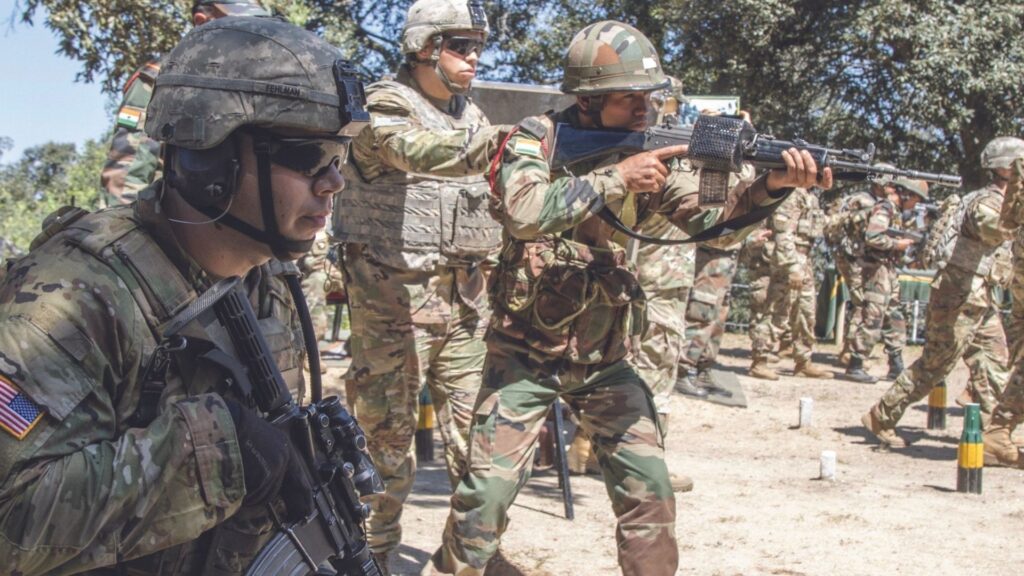
U.S. and Indian soldiers participate in Yudh Abhyas at Chaubattia Military Station in Uttarakhand in 2018. Photograph courtesy U.S. Army
To build on the synergies of our individual service collaborations and to make our forces truly interoperable, we held the first ever tri-services exercise, Tiger Triumph, in November 2019, off the coast of Andhra Pradesh. This exercise, which involved our armies, navies, and air forces, tested our ability both to carry out amphibious landings and to provide humanitarian assistance. Tiger Triumph is expected to take place annually in the future.
As a result of these defense agreements and military exercises, our forces are now working more effectively together to keep the Indo-Pacific free and open. The U.S. and Indian navies seamlessly conduct underwater replenishments, share operational information, and partner on undersea domain awareness to ensure a common understanding of the operating environment in the Indian Ocean. In December 2018, an Indian Navy UH-3H helicopter landed on a U.S. Navy San Antonio-class amphibious transport ship, the USS Anchorage. Landing craft also embarked from the Anchorage to carry out ship-rider exchanges, an exercise often used to combat maritime piracy. Meanwhile, the Anchorage joined in maritime security exercises with an Indian guided-missile destroyer, the INS Rajput.
Increasing Our Security through Exchanges, Training, and Liaison Officers
We have sought to ensure that our military forces are familiar with each other and interoperable on a human level. We did this by increasing exchanges, joint training, and postings of liaison officers. For several years, India has hosted U.S. military students at its National Defence College in New Delhi and its Defence Services Staff College in Wellington, Tamil Nadu. Every year, the United States hosts nine Indian officers at its premier military education institutions through the International Military Education and Training program. Since 2010, over 700 Indian military students have trained in the United States.
In addition to educational exchanges for military students and officers, we have begun exploring the posting of liaison officers at each other’s military facilities. Such postings demonstrate mutual appreciation of each other’s expertise and a high degree of trust. The United States has therefore only pursued them with our closest allies and partners. In 2020, the United States posted an officer to an Indian military facility for the first time – a U.S. naval officer at the newly-established Information Fusion Centre – Indian Ocean Region in Gurugram, Haryana. Similarly, India posted an officer to a U.S. command for the first time – an Indian naval officer at the U.S. Naval Forces Central Command, in Manama, Bahrain.
Strengthening Economies through Defense Technology and Industrial Cooperation
In recent years, the United States and India have significantly expanded defense industrial cooperation, helping ensure that we have the right equipment and platforms to keep our countries safe. The U.S. government and defense industry have increased joint research, production, and defense sales with India. Reflecting our commitment to strengthen India’s defense capabilities and security role in the Indo-Pacific region, the United States has increased the sharing of defense technology and knowledge. India’s increasing use of defense equipment from the United States and other Western partners not only has strengthened India’s military, but also has improved our ability to communicate and operate jointly.
The Indian Air Force now operates 11 C-17 Globemaster aircraft, the largest fleet outside of the United States. These large planes enable India to safely transport personnel and equipment for a range of military and humanitarian missions. In April 2015, the Indian Air Force used three C-17 planes to evacuate people fleeing civil unrest in Yemen. The planes were part of Operation Raahat, an impressive demonstration of India’s ability to play a leading role in the region, as Indian planes and ships rescued over 4,600 Indian citizens and nearly 1,000 foreign nationals.
The Indian Navy is similarly the largest operator, other than the United States, of the P-8 Poseidon, an aircraft specializing in anti-submarine warfare, anti-surface warfare, and shipping interdiction. Other Indo-Pacific countries, such as Australia, South Korea, and New Zealand, operate or plan to operate the P-8 as well, ensuring greater maritime coordination across the region. The Indian military has inducted a range of other U.S.-origin platforms in recent years, including the C-130J Super Hercules transport planes, the AH-64E Apache and CH-47 Chinook attack and transport helicopters, and the M777 Ultra-Lightweight Howitzer artillery guns.
Expanded industrial collaboration has enabled U.S. defense companies to partner with Indian enterprises to develop and manufacture components for global supply chains. Many large U.S. defense firms, including Boeing, Lockheed Martin, BAE Systems, Inc., Raytheon Technologies, General Electric, and L3Harris, now have a presence in India. Their operations include research facilities and large-scale manufacturing, and their partners are small, medium, and large-sized Indian firms. India will soon be home to Boeing’s largest presence outside of the United States, including a campus in Bengaluru that will employ hundreds of Indian engineers. Both Boeing and Lockheed Martin have assembly plants in Hyderabad – Boeing for Apache helicopter fuselages and Lockheed Martin for C-130 empennages and F-16 wings.
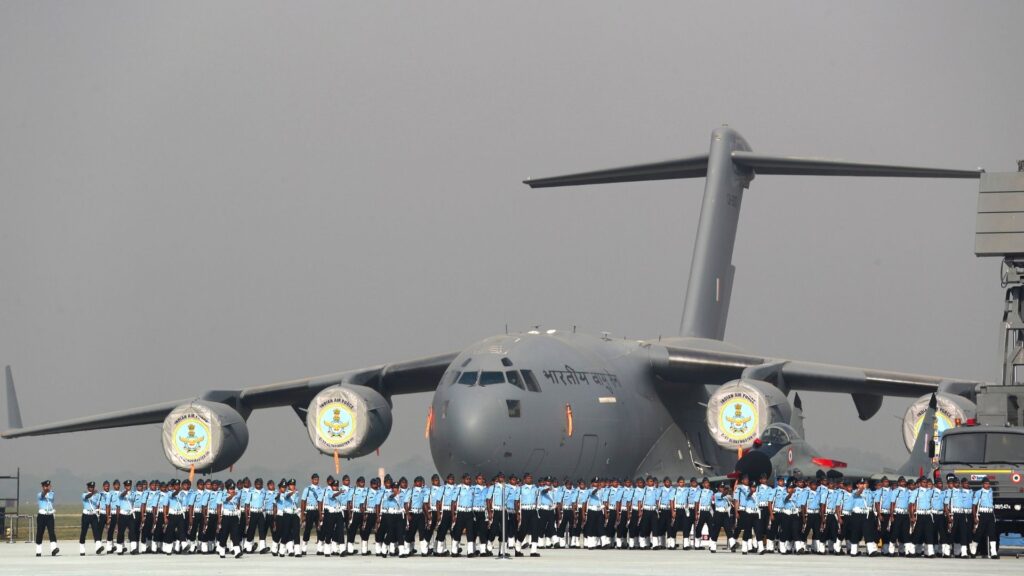
The Indian Air Force operates 11 C-17 Globemaster aircraft. Photograph by Manish Swarup © AP Images
Underlining the growing strength and trust of the defense partnership, the United States has relaxed export controls to India, including granting Strategic Trade Authorization, Tier-1 (STA-1) status to India in 2018. This status increases India’s access to the most advanced defense technology in the world. The flow of advanced U.S. technology to India has grown rapidly, strengthening India’s armed forces, its scientific community, and private industry.
The United States has also made significant diplomatic efforts to encourage other countries to support Indian membership in the four multilateral export control regimes. India has joined three of the regimes – the Missile Technology Control Regime in June 2016, the Wassenaar Arrangement (for dual-use goods and technologies) in December 2017, and the Australia Group (for chemical and biological weapons) in January 2018 – and still seeks membership in the Nuclear Suppliers Group. In light of these developments, India now has access to much of the most advanced technology in the world, and the ability to help design and enforce global non-proliferation controls.
Deepening Cooperation in the Fight Against Terrorism
The growing U.S.-India partnership has strengthened the security of our nations and our region by increasing cooperation against terrorism. In the face of continuing attacks, we have stood together, determined to demonstrate our resilience as diverse and tolerant democratic societies. We have prioritized joint efforts to pursue justice for past attacks and to prevent future terrorist attacks.
The United States and India have regularly discussed terrorism at the highest levels, as demonstrated by strong pronouncements against terrorism in the joint statements following Prime Minister Narendra Modi’s meetings with President Obama and with President Donald J. Trump. We have expanded information sharing, compared analytical work, and coordinated action against regional and global terrorist threats. The U.S.-India Counter Terrorism Joint Working Group, led by the U.S. Department of State and the Indian Ministry of External Affairs, with support from other government agencies, has met over 17 times since 2000. We established a U.S.-India Designations Dialogue in December 2017 to coordinate our approaches to designating individual terrorists and groups.
The U.S. Department of State has partnered with the Indian Ministry of Home Affairs to strengthen counterterrorism training at India’s Central Academy for Police Training in Bhopal, the Central Detective Training Institute in Ghaziabad, and the Sardar Vallabhbhai Patel National Police Academy in Hyderabad. The Department of State has also provided support through the Anti-Terrorism Assistance program, including equipment and training for over 1,000 Indian personnel. Recognizing the importance of expanding international cooperation against terrorism among like-minded partners, India helped broaden our bilateral training efforts by hosting a Quad Counterterrorism Table-Top Exercise in November 2019.
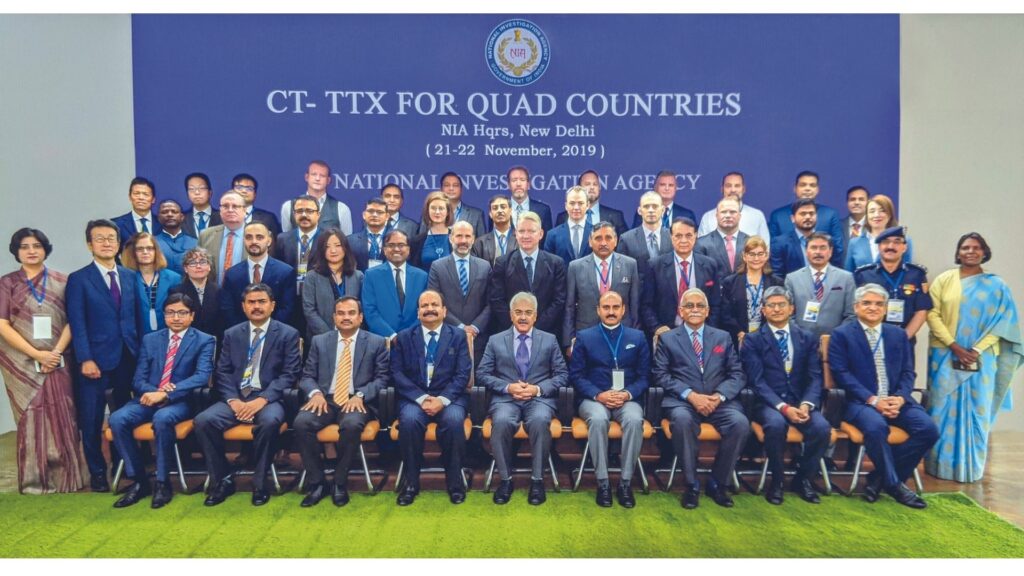
The Indian National Investigation Agency hosted the first counterterrorism exercise with the United States, India, Japan, and Australia in New Delhi in November 2019. Photograph courtesy @State_SCA/Twitter
The Federal Bureau of Investigation (FBI) has continued to work with Indian partners to bring justice for the victims of the 26/11 Mumbai terror attacks. In November 2018, the FBI and the U.S. Department of State established a $5 million Rewards for Justice program to seek information leading to the arrest and conviction of Sajid Mir, the alleged chief planner of the Mumbai attacks. In recent years, the FBI Director and other top officials have met regularly with Indian counterparts. The FBI has worked with Indian partners to offer more than 15 training courses in India, exchanging best practices on topics such as post-blast and terrorism finance investigations, crisis management, and cyber investigations.
Combating the Threats of Drugs and Cybercrime
The United States and India have expanded cooperation to fight a broad range of criminal activity, including illicit drugs and malicious cyber activity. These efforts have received support from the highest levels of government. In February 2020, President Trump and Prime Minister Modi announced the creation of a new Counter-Narcotics Working Group between the law enforcement agencies of our countries to further improve our longstanding cooperation to combat illegal drugs.
The closer partnership has increased policy discussions and training among our law enforcement agencies. For example, the U.S. Drug Enforcement Agency (DEA) has exchanged best practices on combating the trade of synthetic drugs such as Fentanyl with India’s Narcotics Control Bureau (NCB). The U.S. Department of State’s Bureau of International Narcotics and Law Enforcement Affairs has supported multi-year training programs with Indian counterparts and officials from other South Asian countries.
Our bilateral cooperation against illegal drugs has yielded concrete successes. The DEA worked with India’s Directorate of Revenue Intelligence (DRI) and the NCB to seize billions of illicit dosage units of Tramadol, part of the global opioid crisis, from multiple countries around the world. The DEA, the DRI, and the NCB then successfully worked with regulators to update control of Tramadol in 2018, leading to a drastic reduction in abuse of the drug. The DEA and other U.S. law enforcement partners have conducted successful operations with Indian authorities, including the NCB and the Indian Navy’s Information Fusion Centre – Indian Ocean Region, that targeted the maritime smuggling of heroin and other illicit drugs. In 2019, the DEA and the NCB led a combined operation to investigate a drug smuggling organization with ties in the United States, Canada, Australia, and countries in South America. The investigation resulted in the seizure of 200 kilograms of methamphetamine and 70 kilograms of cocaine.
Cybercrime, whether carried out by foreign governments or criminals, is another growing threat to the United States, India, and the world. The United States and India have worked together to protect personal user data, industrial designs, critical infrastructure, and other systems vital to modern societies. This cooperation has ranged from daily information sharing to policy coordination in planned dialogues.
Through the U.S.-India Cyber Dialogue, the United States and India have strengthened our Computer Emergency Response Team (CERT) cooperation and exchanged best practices on malware forensics, critical infrastructure protection, and combating disinformation. During the inaugural U.S.-India Defense Cyber Dialogue in 2020, the United States and India set up working groups to exchange best practices and agreed to explore cyber capacity building.
Looking to the Future
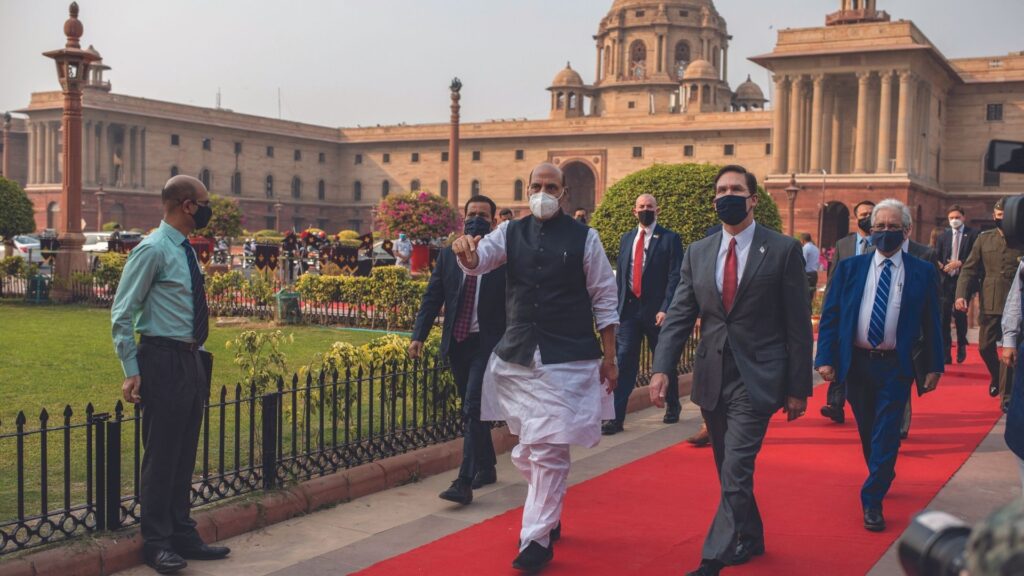
Indian Minister of Defense Rajnath Singh and U.S. Secretary of Defense Mark T. Esper meet before the U.S.-India 2+2 Ministerial Dialogue in October 2020. Photograph by Altaf Qadri © AP Images
Our recent progress on defense and security issues, building on many years of history, has contributed to the safety of our citizens and the Indo-Pacific region. The habits of cooperation, personal ties, expertise, and equipment we have developed have prepared us to deal with future threats and challenges. As leading democracies in the Indo-Pacific, and indeed the world, we stand prepared to ensure that our peoples and those of other nations have the opportunity to thrive in a rules-based international order.
Tiger Triumph
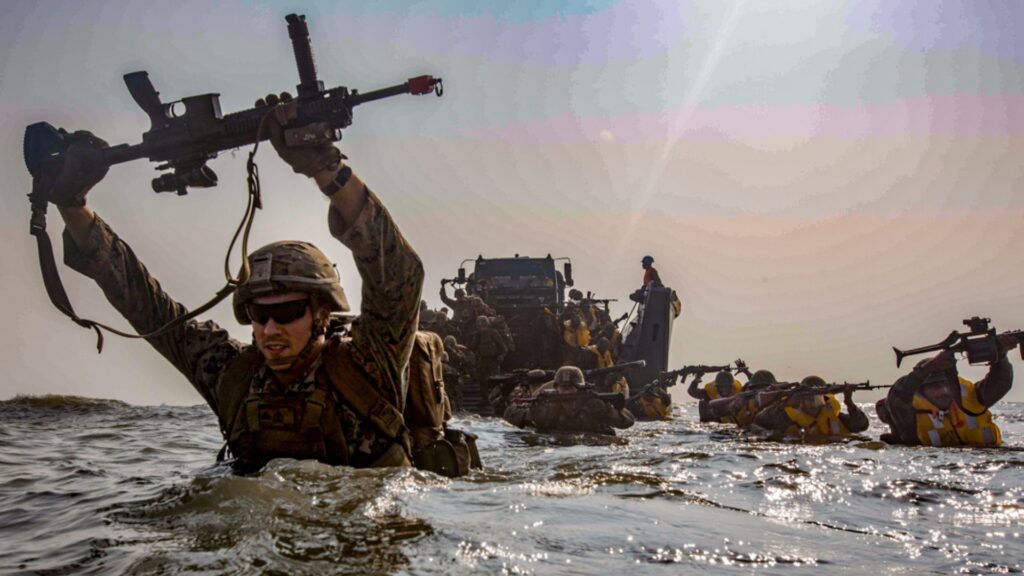
U.S. and Indian service members participate in Tiger Triumph off the coast of Andhra Pradesh. Photograph by U.S. Marine Corps/Lance Cpl. Christian Ayers
All three Indian military services trained alongside the U.S. Army, Navy, and Air Force in 2019 for our first tri-services military exercise. The exercise, named Tiger Triumph, is part of the ongoing partnership between the U.S. and Indian militaries and is a key component of securing the Indo-Pacific.
“The U.S.-India partnership at sea is critical to ensuring the safety of sea lanes and advancing maritime security in the Indo-Pacific region,” U.S. Ambassador to India Kenneth I. Juster stated at the inauguration of the November 13-21 exercise. “The U.S.-India defense partnership is very strong and getting even stronger.”
Tiger Triumph focused on humanitarian assistance and disaster relief, and included amphibious operations. The “Triumph” in its name stands for Tri-Services India U.S. Amphibious Exercise.
“The United States will stand with the people of India as they confront threats to their sovereignty and to their liberty,” U.S. Secretary of State Michael R. Pompeo stated during the press conference at the third U.S.-India 2+2 Ministerial Dialogue in October 2020. He added that “the United States and India are taking steps to strengthen our cooperation against all manner of threats.”
Bringing Criminals to Justice
India is a critical law enforcement partner in South Asia. The FBI’s New Delhi Legal Attaché Office collaborates closely with Indian security agencies on a multitude of issues, including terrorism, cybercrime, transnational organized crime, and prevention of child sexual abuse. The FBI’s close partnership with Indian counterparts has resulted in disruption of criminal activity and terrorist attacks through investigative exchanges and capacity building programs.
The FBI and Indian law enforcement have worked together to disrupt ongoing criminal activity by various fraudulent call centers throughout India. The fraudulent call centers target elder Americans, resulting in hundreds of millions of dollars’ worth of losses. The criminals use technical means to conduct fraud by impersonating U.S. or Indian law enforcement officials. For example, in November 2018, Indian federal and state law enforcement officials, working jointly with the FBI, executed simultaneous arrests and searches at over 16 fraudulent call centers in Gurugram, Haryana and Noida, Uttar Pradesh. The FBI and Indian law enforcement partners remain committed to stopping any criminal activity that affects the United States and India.
COMMENTS